
Muraena is a genus of twelve species of large eels in the family Muraenidae.

The barred moray, also known as the banded moray, the dark-banded eel, the girdled moray, the girdled reef eel, the many banded moray eel, the ringed moray, the ringed reef moray, the striped moray and the zebra eel,) is a moray eel of the family Muraenidae. It was described by John Richardson in 1845, originally under the genus Muraena. It is a marine, tropical eel which is known from the Indo-Pacific, including the Red Sea, East Africa, the Hawaiian Islands, the Marquesan Islands, the Tuamoto Islands, the Ryukyu Islands, and the Great Barrier Reef. It dwells at a depth range of 2 to 20 metres, and leads a benthic lifestyle in reefs and shallow lagoons. Males can reach a maximum total length of 72.3 centimetres (28.5 in).
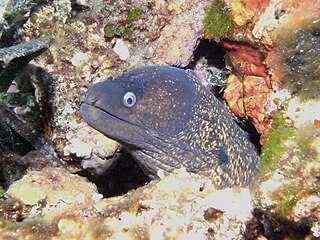
The Mediterranean moray is a fish of the moray eel family. It has a long eel-like body and is found in the eastern Atlantic Ocean and Mediterranean Sea. Its bite can be dangerous to humans.
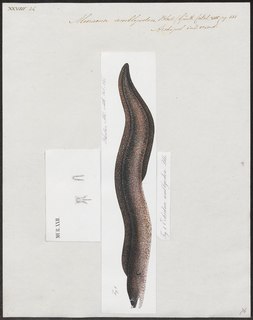
Echidna amblyodon, the Sulawesi moray is a moray eel found in the western central Pacific Ocean. It was described by Bleeker in 1856, originally under the genus Muraena. It is a marine, tropical eel which is known from Indonesia, in the western central Pacific Ocean. Males can reach a maximum total length of 20.5 centimetres (8.1 in).
Echidna nocturna is a moray eel found in the eastern Pacific Ocean, in the Gulf of California and around Peru and the Galapagos Islands. It was first named by Cope in 1872, and is commonly known as the freckled moray or the palenose moray. It was discovered that Echidna nocturna and Muraena acutis are the same species.
Muraena appendiculata is a moray eel found in the southeast Pacific Ocean around Chile. It was described by Alphone Guichenot in 1848, originally under the genus Muraenophis.

Muraena argus, commonly known as the white-spotted moray, or the Argus moray, is a moray eel found in coral reefs from Mexico to Peru and around the Galápagos Islands. It was described by Franz Steindachner in 1870, originally under the genus Gymnothorax. It dwells at a depth range of 18 to 60 metres. Males can reach a maximum total length of 120 centimetres (47 in), but more commonly reach a TL of 60 centimetres (24 in).
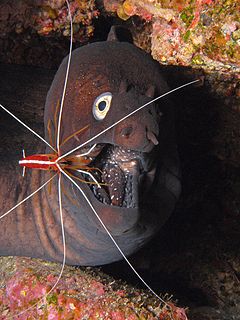
Muraena augusti is a moray eel found north of the eastern Central Atlantic ocean. It was described by Johann Jakob Kaup in 1856, originally under the genus Thyrsoidea. It is non-migratory, and dwells at a depth range of 0 to 250 metres, most often at around 0 to 50 metres.
Muraena clepsydra, commonly known as the hourglass moray, is a moray eel found in coral reefs from the Gulf of California to Peru, and the Galapagos Islands. It was described by Charles Henry Gilbert in 1898. It dwells at a depth range of 0 to 25 metres. Males can reach a maximum total length of 120 centimetres (47 in), but more commonly reach a TL of 60 centimetres (24 in).
Muraena melanotis is a moray eel found in the eastern and western Atlantic Ocean. It is commonly known as the honeycomb moray. It grows to am maximum length of about 1 metre.
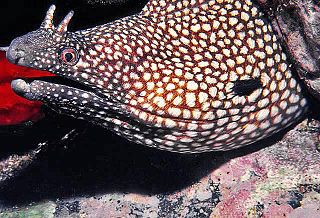
Muraena pavonina is a moray eel that occurs in the western and eastern Atlantic Ocean. It is found in holes and crevices at depth 2–60 m. This species has a maximum length of 51.2 cm (20.2 in).

The African longfin eel, also known simply as the longfin eel, is an eel in the family Anguillidae. It was described by Wilhelm Peters in 1852, originally under the genus Muraena. It is a tropical eel known from freshwaters in southern Kenya, Cape Agulhas, Madagascar, and New Caledonia. The eels spend most of their lives in freshwaters far inland, but migrate to the Western Indian Ocean to breed. Males can reach a maximum total length of 150 centimetres; females can reach a maximum standard length of 120 centimetres and a maximum weight of 5,000 grams. The eels can live for about 20 years. Juveniles and adults are known to feed off of carcasses, crabs, and bony fish.
The purple spaghetti-eel is an eel in the family Moringuidae. It was described by Francis Buchanan-Hamilton in 1822, originally under the genus Muraena. It is a tropical, freshwater eel which is known from India, Bangladesh, Nepal, Indonesia, and the Philippines. It inhabits rivers and estuaries. Males can reach a maximum standard length of 44 cm.

The bandtooth conger, also known as the Baleares conger or the Balearic conger, is an eel in the family Congridae. It was described by François Étienne Delaroche in 1809, originally under the genus Muraena. It is a subtropical, marine eel which is known from the western and eastern Atlantic and the western Indian Ocean, including North Carolina, USA; the northern Gulf of Mexico, northern South America, Canada, Portugal, Angola, the Mediterranean, and the Red Sea. It inhabits reefs and littoral shelves, and burrows into sand and mud. It dwells at a depth range of 1–732 meters, but most frequently between 20–100 m. Males can reach a maximum total length of 35 centimetres, but more commonly reach a TL of 25 centimetres (9.8 in)

The Thinlip conger is an eel in the family Congridae. It was described by François Étienne Delaroche in 1809, originally under the genus Muraena. It is a subtropical, marine eel which is known from the eastern Atlantic Ocean, including southern Portugal, the Mediterranean, and Morocco. It dwells at a depth range of 75–800 metres, and inhabits mud and sand on the continental slope. Males can reach a maximum total length of 60 centimetres, but more commonly reach a TL of 35 centimetres.
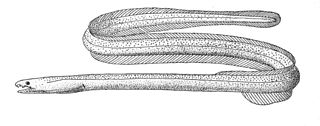
Muraenichthys gymnopterus is an eel in the family Ophichthidae. It was described by Pieter Bleeker in 1853, originally under the genus Muraena. It is a marine, tropical eel which is known from the western Pacific Ocean, including China, Indonesia, and India. It inhabits rocky reefs in shallow, warm seas. Males can reach a maximum total length of 30 centimetres (12 in).

The blotched snake eel is an eel in the family Ophichthidae. It was described by David Starr Jordan and Barton Warren Evermann in 1887. It is a rare tropical, marine eel which is known from the western and northwestern Atlantic Ocean, including the United States, the Gulf of Mexico, the Yucatan Peninsula, and Canada. It dwells at a depth range of 27–115 metres. Males can reach a maximum total length of 60 centimetres.

The Painted eel is an eel in the family Ophichthidae. It was described by Carl Linnaeus in 1758, originally under the genus Muraena. It is a marine, subtropical eel which is known from the eastern Atlantic Ocean, including the Bay of Biscay, the Republic of Congo, and the Mediterranean. It dwells at a depth range of 3 to 12 metres, and inhabits burrows formed in sand and mud sediments in coastal lagoons and estuaries. Males can reach a maximum total length of 100 centimetres (39 in), but more commonly reach a TL of 60 centimetres (24 in).
The Spotted snake eel is an eel in the family Ophichthidae. It was described by Carl Linnaeus in 1758, originally under the genus Muraena. It is a marine, subtropical eel which is known from the western and eastern Atlantic Ocean, including Bermuda and southern Florida, USA, Brazil, Lesser Antilles, Senegal, Angola, and the Mediterranean. It dwells at a depth range of 21 to 50 metres, usually at around 50 m, and lives in burrows on a permanent basis. Males can reach a maximum total length of 210 centimeters (83 in), but more commonly reach a TL of 100 centimeters (39 in).










